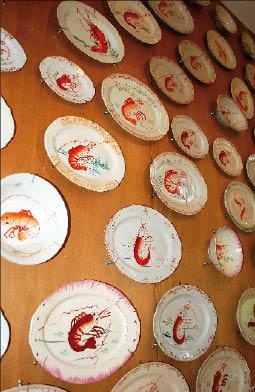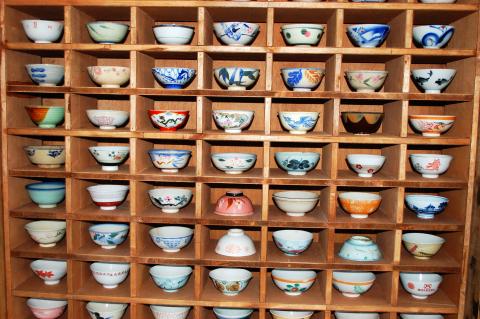The Taiwan Bowl and Dish Museum opened in Yilan County’s Yuanshan Township this past Saturday, housing an art collection of over 20,000 bowls, plates and other eating utensils. Chien Yang-tong, the museum’s founder, says that regardless of whether a person is poor or rich, bowls and plates are still used when a person eats their three daily meals. During the 30 years following World War II, it was popular to paint bowls and plates by hand, which feature a lot of local characteristics, for example, auspicious designs consisting of fish and shrimp, coconuts and the ocean, plum blossoms and orchids, bamboo and chrysanthemums, or even Fukurokuju, the god of happiness, wealth, and longevity in Japanese mythology, all representing the contemporary culture at the time they were made.
Chien says that since the 1970s, plastic eating utensils and machine-made ceramics have become common, causing people to feel a sense of nostalgia for the hand-painted eating utensils of our grandparents’ generation, back when every plate and bowl’s design was slightly different. Although the craftsmanship of ceramics at the time was far from perfect, they still give people a sense of ancient simplicity and refined familiarity, speaking volumes to the arduous enterprise craftsmen undertook to make them.
The museum is located inside Surewell’s headquarters next to Yuanshan’s Leikung Lake. It opens daily from 9am to 5pm. Tickets are NT$120, but there is a 50 percent discount for the first three months they are open, and children less than 120cm tall and disabled people can visit the museum free of admission. For more information visit the museum’s Web site at http://www.facebook.com/Taiwan.Bowl.Dish.Museum.
(Liberty Times, Translated by Kyle Jeffcoat)

Photo: Yang Yi-min, Liberty Times
照片:自由時報記者楊宜敏
蒐集二萬多件碗盤藝術品的台灣碗盤博物館,上週六在宜蘭縣員山鄉開幕,博物館創辦人簡陽同說,吃飯的碗盤,不論是市井小民或家財萬貫的富翁,每天三餐都會使用到,尤其是二次世界大戰後三十年,台灣的手工彩繪碗盤興盛,極具台灣在地特色,像是魚蝦、椰風海景,或是梅蘭竹菊、甚至日本神話中的「福祿壽」等吉祥圖案,都反映當時的社會文化。
他說,七十年代以後,塑膠餐具製品興起、機械生產的陶瓷,更讓人懷念阿公阿嬤時代手繪、每個圖案都不盡相同的碗盤,雖然當時的陶瓷作工較為粗糙,卻給人一種古樸素雅的親切感,更道盡先民篳路藍縷的辛勞。
台灣陶瓷博物館開設在員山鄉雷公埤旁的喜互惠總部內,每天開館時間為上午九時到下午五時,門票原價一百二十元,開幕前三個月五折優待,身心障礙者憑證或一百二十公分以下兒童免費入館。更多資訊可洽官方網站:http://www.facebook.com/Taiwan.Bowl.Dish.Museum。
(自由時報記者楊宜敏)

Photo: Yang Yi-min, Liberty Times
照片:自由時報記者楊宜敏

Photo: Yang Yi-min, Liberty Times
照片:自由時報記者楊宜敏

A: Although the scandalous Eastern superstar Kim Soo-hyun canceled his visit, Western superstar Andrea Bocelli is visiting Taiwan over the long weekend. B: Yup, the blind tenor will become the first Western artist to hold a concert at the Taipei Dome tonight. A: Pop diva Celine Dion even praised him: “If god would have a singing voice, he would sound a lot like Andrea Bocelli.” B: I love their duet, “The Prayer.” I even played the song at my sister’s wedding for the newlyweds. A: Two Taiwanese singers, A-mei and A-lin, sang with Bocelli before. It would be great

In the vast landscapes of Australia, a unique and charming creature roams — the “wombat.” These round, adorable animals possess surprising abilities and fascinating traits that never fail to amaze. Let’s explore the world of this remarkable creature. Wombats are marsupials native to Australia, measuring around one meter in length and weighing between 20 and 35kg. Their fur varies in color, ranging from brown to gray to black. As herbivores, they primarily feed on grass, bark and roots. To adapt to Australia’s weather conditions, wombats have developed a slow metabolism and a leisurely pace. However, despite their bulky appearance,

Bilingual Story is a fictionalized account. 雙語故事部分內容純屬虛構。 Echo pulled out a worn and tattered shoe box under father’s large oak desk. “Mariko, what should we do with these family photos?” Mariko stared at the old box with a slightly hurt expression, and then blankly at the photos. “Throw them in the garbage pile. . . along with that old, ratty box,” she murmured. She resented that her father had not cared enough to find a nicer home for the family photos. “Father never really cared about me anyway.” Echo’s emotion sensor detected sorrow. ”Mariko, that is

A: The four-day long weekend for Tomb-sweeping Day begins today. Are you going south to sweep tombs this weekend? B: I went south early last weekend, so I could attend South Korean actor Kim Soo-hyun’s show at the Kaohsiung Sakura Festival, but he canceled his visit after a scandal broke out. A: The late actress Kim Sae-ron’s family accused him of dating her since she was a minor, at just 15 years old. Fans are shocked. B: Didn’t the media report that the age of consent in South Korea used to be 13? Technically, he didn’t break the law. A: